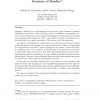Free Online Productivity Tools
i2Speak
i2Symbol
i2OCR
iTex2Img
iWeb2Print
iWeb2Shot
i2Type
iPdf2Split
iPdf2Merge
i2Bopomofo
i2Arabic
i2Style
i2Image
i2PDF
iLatex2Rtf
Sci2ools
TCS
2002
2002
Authentication tests and the structure of bundles
Suppose a principal in a cryptographic protocol creates and transmits a message containing a new value v, later receiving v back in a different cryptographic context. It can conclude that some principal possessing the relevant key has received and transformed the message in which v was emitted. In some circumstances, this principal must be a regular participant of the protocol, not the penetrator. An inference of this kind is an authentication test. We introduce two main kinds of authentication test. An outgoing test is one in which the new value v is transmitted in encrypted form, and only a regular participant can extract it from that form. An incoming test is one in which v is received back in encrypted form, and only a regular participant can put it in that form. We combine these two tests with a supplementary idea, the unsolicited test, and a related method for checking that keys remain secret. Together, these techniques determine what authentication properties are achieved by a ...
Authentication Tests | Cryptographic Protocol | Regular Participant | TCS 2002 | Theoretical Computer Science |
| Added | 23 Dec 2010 |
| Updated | 23 Dec 2010 |
| Type | Journal |
| Year | 2002 |
| Where | TCS |
| Authors | Joshua D. Guttman, F. Javier Thayer |
Comments (0)

